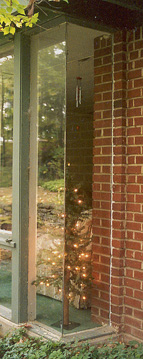The Muschlitz House
William and Mary Frances Gregory Muschlitz
454 Whitehall Road
1950

The Muschlitz House is one of an adjoining pair built for two Gregory sisters and their husbands in a three acre wooded plot off of Whitehall Road near the YMCA. At the time the area was all fields and woods and there was little traffic on the country road. The plot is large enough that one can still drive by and not notice that the homes are there.
William Muschlitz was a program director in electrical engineering for commonwealth campuses at Penn State. Mary Frances was an administrator in the newly created Office of Personnel Relations (now Human Resources) in Old Main (two miles into town). Their brother-in-law George Nelson had been a student of Phil’s and admired his work, thus resulting in his selection as their architect.
The nearly level site was considerably different than the steep hillsides that Hallock often encountered. The dwellings have long, linear lines and almost seem to grow out of the land. The homes were built on concrete slabs and featured radiant heating in the floors. There are no viewing windows on the road side, but window walls face toward the South. The roofs are flat, but have two heights to provide for tray ceilings with clerestory windows within.

The perpendicular walls on the entry side of the dwelling draw visitors directly to the front door. The Muschlitz and Nelson houses are very similar in design and, except for the window treatments of the bedroom wing to the left, the entries appear the same. On both there is a carport to the right with a covered walkway leading to the front door. Both also had sheltered terraces between the house proper and the carport. The Muschlitz home is larger, though, with four bedrooms and two baths.

Hallock's initial sketch for the entry shows vertical siding to the left of the door and a brick wall to the right.

The home was built per the sketch, but appears more vertical in reality.

Away from the road, woodland paths lead to the South-facing window walls of the house. Original landscaping was done by Wayne Wilson, a former head of Landscape Architecture at Penn State.

The landscape is stark in the winter, but the leafless trees allow much more light into the dwelling. The leftmost and rightmost rooms were formerly patio areas which have been enclosed.



One of the most distinguishing features of the house is the living room bay window treatment, shown above. The two corner windows are full height frameless glass, as pioneered by Frank Lloyd Wright. The home was as the end of the power line when built and the power frequently went out during storms. In the winter on such occasions the family would melt snow and roast hotdogs in the fireplace.

The East bedroom outside wall has a standard window treatment that is set off by contrasting colors. Divorced not long after the house completion, Mary Frances remained and raised her three children there. She found the house "the most wonderful" she has ever lived in and was there over 40 years.

The bedroom area features a novel window treatment that is unique to Hallock homes in the area. The vertical boards (to the left) are redwood planks, originally left in their natural color. Also notice how the mortar is grooved to give long horizontal lines to the blocks.

A recent addition to the house is a solarium; it looks almost like it is standing alone. However, it is attached at the back to the bedroom area (look closely to the left, rear of the room). Formerly a patio area, the addition has the same architectural style and blends in nicely.